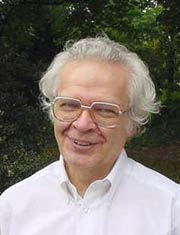1979 The hyperchaotic Rössler system
 The system
The system
Up until now we have studied chaotic behavior that is generated by the complementarity between a stretching direction and a squeezing direction. When the evolution of a system occurs in a four-dimensional space, a second stretching direction can appear. Sketch of hyperchaotic trajectory located at the intersection of two expanding directions S’ and one contracting surface S. A double difficulty is encountered when a description is attempted : one is related to the phase space which has four dimensions and another results from the foliated structure due the combination of the two unstable manifolds (Fig. 1).
In 1979 Otto Rössler proposed the set of equations [1].

which produces such behavior.
Without the third variable ![]() , the solutions to this system are ejected to infinity. Variable
, the solutions to this system are ejected to infinity. Variable ![]() acts as a retroaction beyond a given threshold and ensure the folding which sends the trajectory back to the center of the attractor (Fig. 2). Rössler called this behavior characterized by two positive Lyapunov exponents a hyperchaotic attractor. A possible set of initial conditions is (x,y,z,w)=(-10, -6, 0, 10.1). The dissipation rate provided by the mean value of the trace of the Jacobian matrix (normalized by the number of revolution over the attractor) is - 33081.
acts as a retroaction beyond a given threshold and ensure the folding which sends the trajectory back to the center of the attractor (Fig. 2). Rössler called this behavior characterized by two positive Lyapunov exponents a hyperchaotic attractor. A possible set of initial conditions is (x,y,z,w)=(-10, -6, 0, 10.1). The dissipation rate provided by the mean value of the trace of the Jacobian matrix (normalized by the number of revolution over the attractor) is - 33081.
- Fig. 2. Hyperchaotic attractor produced by the four-dimensional Rössler system.
The equations in this model are not particularly complicated, other than for the fact that they are four-dimensional. The two stretching directions produce a first return map without any very clear structure ; this does not allow a partition to be constructed for this attractor (Fig. 3). Because of the thickness of the first-return map, it is quite unlikely that a template can correctly describe the structure of this attractor. The topological description of such a structure is currently an open question but... coming soon ?
- Fig. 3. First-return map to a Poincaré section of the hyperchaotic attractor.




